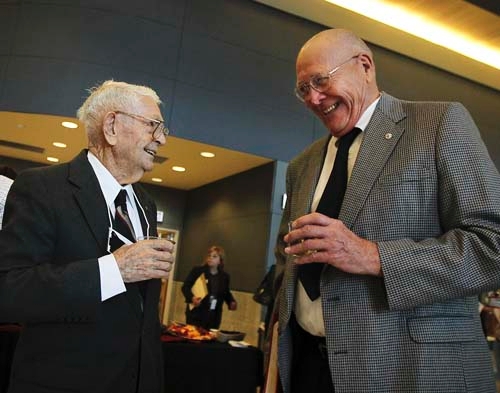Pilots remember heyday of Southern Nevada aviation
Behemoth black jets flew from a secret airstrip along the Groom Dry Lake bed in the 1960s, catching commercial jetliner pilots off guard and sending out sonic booms that signaled the prowess of U.S. aviation during the Cold War.
The jets conjured visions of UFOs, unidentified flying objects, to unsuspecting observers on the ground who occasionally caught a glimpse. That added to the mystique about the classified military installation known as Area 51, about 90 miles northwest of Las Vegas as the crow flies, or more than a 150-mile drive over Southern Nevada's remote terrain to reach the restricted location flanked by what was then called the Nevada Test Site, now the Nevada National Security Site.
A panel of test pilots and crew members, most of them in their 80s, talked Tuesday night at the National Atomic Testing Museum about the heyday of what were called Lockheed's "Blackbirds."
These included two spy planes, the A-12 and the SR-71, and the record-setting interceptor jet, the YF-12, armed with three missiles that could be fired at fast-flying targets over land or sea.
The panel's discussion focused on the Air Force YF-12 interceptor jet. The talk was the first of a lecture series that coincides with the "Area 51 Myth or Reality" exhibit, which runs for the next 18 months at the museum, 755 E. Flamingo Road.
"The YF-12 really did a nice thing for the CIA. It was really a cover," said Sam Ursini, 79, of San Diego, a retired Air Force colonel who was the interceptor jet's weapons officer.
"Everyone focused on the YF-12, but the real action was the A-12 over Southeast Asia," he said.
The A-12 was developed in the early 1960s under the CIA's Oxcart program as a reconnaissance aircraft to spy on enemy forces during the Vietnam War.
The YF-12 and its sister Blackbird jets routinely broke the sound barrier, sending out booming shock waves as they flew faster than the speed of sound at standard sea-level conditions, more than 761 mph, also known as Mach 1. Sometimes they flew more than three times that, or Mach 3 plus.
Test pilot Jim Eastham was at the stick of the two-cockpit YF-12A on its maiden flight out of Area 51.
President Lyndon B. Johnson announced the aircraft's existence on Feb. 29, 1964, calling it the A-11 to throw a curveball to curious Soviet officials, who saw it as air-superiority competition for their MiG-25 Foxbat supersonic interceptor spy plane.
Prospects for the YF-12 setting new speed and altitude records were good, but the chances would be reserved for Air Force pilots, not former World War II and Korean War pilots such as Eastham, who worked for Lockheed.
"You really end up with a bunch of egomaniacs once you get into this business," said Eastham, 88, of Meridian, Miss. He was referring to the government's agreement with its contractor that "all records will be set by the Air Force with Air Force pilots."
The YF-12A set a speed record of more than 2,070 mph, and a sustained altitude record of nearly 80,258 feet, according to aerospace historian Peter Merlin. The crew for the altitude record was Air Force Col. Robert L. Stephens and Lt. Col. Daniel Andre.
With the YF-12 getting more flying time out of Area 51, it would sometimes cross into airspace shared with commercial passenger planes.
Ursini said airline pilots who would see these Blackbirds flying over Nevada and California would be met by government security personnel at their destinations, typically Los Angeles International Airport, and asked to describe what they saw.
Their answers varied, depending on their viewing angle of the jet with its long, sleek fuselage and twin tail fins behind the two engines that each had the point of a cone protruding from them.
"People were starting to see it," Ursini said. "You just can't hide it forever."
A year after the YF-12's record-setting feats, pilot Bill Weaver found out how risky it was to fly the SR-71 at such mind-boggling speeds and altitudes.
In January 1966 with retired Air Force Lt. Col. Jim Zwayer as his weapons-and-radar specialist in the second cockpit, Weaver experienced the unthinkable: The aircraft broke apart while they were flying Mach 3.18 at 78,800 feet.
Zwayer broke his neck and died as they shot from their seats in their pressurized suits.
Weaver lost consciousness as he fell through the frigid, thin air, but his parachute opened. He said he gradually regained consciousness but was in a trance, almost hallucinating, he said, thinking he was having a bad dream as he spiraled toward the snow-covered, high desert below.
When he snapped out of it with his chute deployed, he began to realize what had happened. But he couldn't see anything because the face shield on his helmet had iced up.
"I was real happy I was out of the airplane," he said after Tuesday night's panel discussion.
When he hit the ground, he wondered how he was going to survive the night on this desolate terrain, 60 miles north of Tucumcari, N.M.
Then he heard a man's voice behind him. "Are you OK, sir?" the man asked.
Weaver turned around, lifted his face shield, and saw the man wearing a cowboy hat. This rancher, he said, had been flying a helicopter across his 200,000-acre spread when he saw the disaster unfold. He landed the helicopter near where he saw Weaver's parachute collapse. And within a few minutes, they were on their way to a hospital.
Contact reporter Keith Rogers at krogers@reviewjournal.com or 702-383-0308.






















